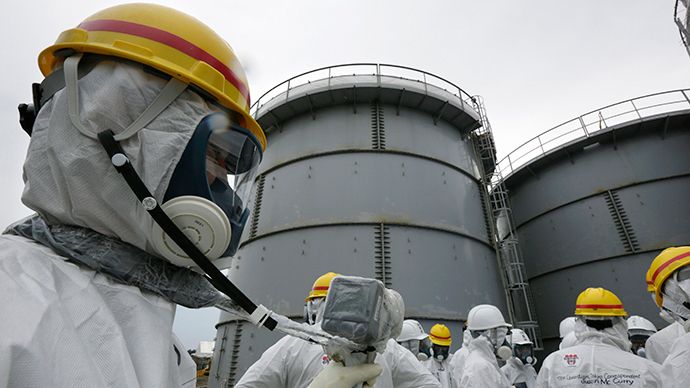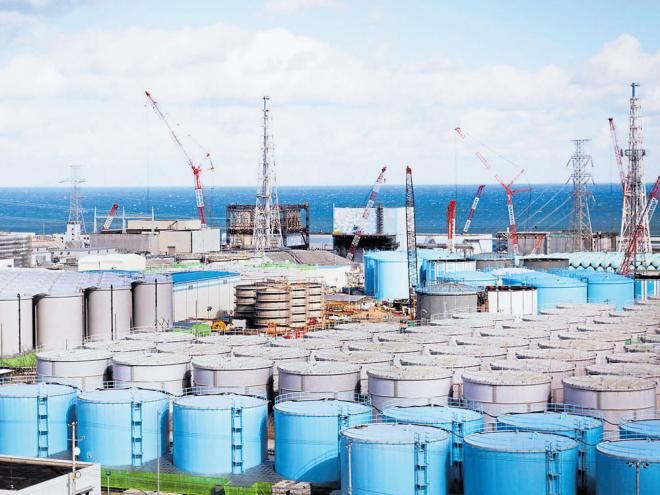Fukushima's Waste Still Damages the Environment
Published on by Water Network Research, Official research team of The Water Network in Social
Six years after the largest nuclear disaster, Japanese officials have still not solved a basic problem: what to do with an ever-growing pile of radioactive waste.
 400 tonnes of contaminated water per day due to Fukushima disaster still today still have effect on the environment.
400 tonnes of contaminated water per day due to Fukushima disaster still today still have effect on the environment.
The Tokyo Electric Power Company is pumping water non-stop through the three reactors to cool melted fuel that remains too hot and radioactive to remove.
The water picks up radiation in the reactors and then is diverted into a decontamination facility.
But the decontamination filters cannot remove all the radioactive material. So for now, all this water is being stored in 1,000 gray, blue and white tanks on the grounds. The tanks already hold 9,62,000 tonnes of contaminated water, and Tokyo Electric is installing more tanks. It is also trying to slow the flow of groundwater through the reactors by building an underground ice wall.
Within a few years, though, and no one is sure exactly when, the plant may run out of room to store the contaminated water. “We cannot continue to build tanks forever,” said Shigenori Hata, an official at the Ministry of Economy, Trade and Industry.
Authorities are debating whether it might be acceptable, given the relatively low radioactive levels in the water, to dilute the contaminated water and then dump it into the ocean. But local fishermen are vehemently opposed. Many people still do not trust Tokyo Electric because of its bungled response to the disaster, the worst nuclear accident since Chernobyl.
 — 3,519 containers of radioactive sludge: The process of decontaminating water leaves radioactive sludge trapped in filters, which are being held in thousands of containers of different sizes. Tokyo Electric says it cannot quantify the amount of radioactive sludge being generated. But it says it is experimenting with what to do with it, including mixing it with cement or iron. Then it will have to decide how to store it.
— 3,519 containers of radioactive sludge: The process of decontaminating water leaves radioactive sludge trapped in filters, which are being held in thousands of containers of different sizes. Tokyo Electric says it cannot quantify the amount of radioactive sludge being generated. But it says it is experimenting with what to do with it, including mixing it with cement or iron. Then it will have to decide how to store it.
— 64,700 cubic metres of discarded protective clothing: The estimated 6,000 cleanup workers at the site put on new protective gear every day. These hazmat suits, face masks, rubber gloves and shoe coverings are thrown out at the end of each shift. The clothing is compressed and stored in 1,000 steel boxes stacked around the site.
To date, more than 64,700 cubic metres of gear has been discarded, the equivalent of 17 million 1-gallon containers. Tokyo Electric says it will eventually incinerate all this contaminated clothing to reduce the space needed to store it.
— Branches and logs from 220 acres of deforested land: The plant’s grounds were once dotted with trees, and a portion was even designated as a bird sanctuary. But workers have cleared about 220 acres of trees since the meltdown spewed radiation over them. Now, piles of branches and tree trunks are stacked all over the site.
Officials say there are about 80,000 cubic metres of this waste, and all of it will have to be incinerated and stored someday. — 2,00,400 cubic metres of radioactive rubble: Explosions during the meltdown filled the reactors with rubble. Workers and robots are slowly and carefully trying to remove this tangled mass of crushed concrete, pipes, hoses and metal. Tokyo Electric estimates that more than 2,00,400 cubic metres of rubble — all of it radioactive — have been removed so far and stored in custom-made steel boxes.
That is the equivalent of about 3,000 standard 40-foot shipping containers. — 3.5 billion gallons of soil: Thousands of plastic garbage bags sit in neat rows in the fields and abandoned towns surrounding the Fukushima plant. They contain soil that was scraped from land that was exposed to radiation in the days after the accident.
The ultimate goal of the cleanup is to cool and, if possible, remove the uranium and plutonium fuel that was inside the three reactors at the time of the disaster.
Source: Deccan Herald
Media
Taxonomy
- Water Pollution
- Environment
- Pollution
- Water Pollution Control
- Groundwater Pollution
- Environment
- Nuclear Waste Disposal